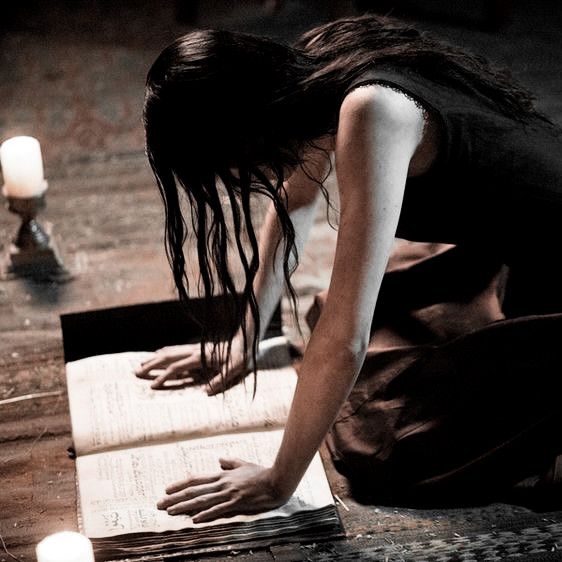
Lethe, Greek Goddess of Oblivion
The souls that throng the flood
Virgil
Are those to whom, by Fate, are other bodies owed,
In Lethe’s lake they long oblivion taste,
Of future life secure, forgetful of the past.
Mythology
Lethe is one of the five rivers of the Greek underworld, and the personification of forgetfulness. When spirits are ready to be reborn, they must drink from the waters of Lethe in order to forget their previous lives. She may also be invoked to forget that which is too painful to bear, and has the power to sever bonds lingering from past lives. She is said to mark the border between the Underworld and the Fields of Elysium, ensuring no unworthy souls may wander into a more comfortable existence. Her source bubbles from the cave of Hypnos.
Only the lazy stream of Lethe ‘neath the rock with whisper low o’er pebbly shallows trickling lulls to sleep. Before the cavern’s mouth lush poppies grow and countless herbs, from whose bland essences a drowsy infusion dewy Nyx distils and sprinkles sleep across the darkening world.
Ovid
According to one myth, Medea used Lethe River water to sedate the dragon that guarded the Golden Fleece, thus enabling Jason to steal it.
Rarer still, Lethe is sometimes attributed as the mother of the Three Charities.
Some myths say that the river Lethe runs parallel to the river Mnemosyne, the river of memory, and the dead may choose to forget their lives by drinking from Lethe, or end future reincarnations of their soul by drinking from Mnemosyne. However Mnemosyne herself was a titan goddess and mother to the nine muses, so it is likely these myths have been conflated. Spirits usually have control over the antidotes to their domain, thus Lethe may have been able to reawaken memories or reverse loss of memory.
Drinking from both rivers is believed to confer prophetic visions. In Classical Greek, the word lethe (λήθη) literally means “oblivion”, “forgetfulness”, or “concealment”. It is related to the Greek word for “truth”, aletheia

Now did Aeneas descry deep in a valley retiring, a wood, a secluded copse whose branches soughed in the wind, and the Lethe River drifting past the tranquil places.
Virgil
Lethe, in the 6th Age

Lethe was one of many children abandoned by Eris. She was raised instead by her grandmother, Nyx, and grew up loyal to Hades, ultimately becoming one of his tools during the godwars. Much of her work did not last transcription into myth, or was purposefully concealed, and some was even attributed to other gods. Her talents lay in dreamwalking and the manipulation of dreams, particularly the subtleties of memory. She was later revealed to be one of the Age’s rare dreamweavers. Given these talents she often worked alongside the court of the Oneiroi, which was governed by Morpheus.
No real attachments mark her known history, and she has no recorded spouse or children. Given the child-like nature of her waking innocence it was difficult to contemplate her with such relationships.
Awake
“It was easy to leave you.”
Eris



Lethe’s childhood was spent at the heels of Nyx, beneath the realm of Hades in the formidable prison of Tartarus. She grew up around the monsters her grandmother commanded, and never saw them as such; an attitude that persists between the Ages. She was a strange child, insatiably curious, and always drawing. When Nyx realised there was more to her scribblings than met the eye, she began to take Lethe into the pocket dimensions she used for her research.
Sit still now, child. This will only sting a moment, I promise
Nyx
Time ran differently in the vacuoles. Though Lethe always considered it a sanctuary, Nyx also experimented on her in there, discovering the glyph which binds Lethe’s soul to the Wheel. Because of the location’s proximity to the edge of the Pattern, it’s one of the only places the symbol is visible on the skin.

Lethe spent a great deal of time here throughout her life, so much so that Nyx created rooms for her attached to the Nexus. Lethe’s door was marked with the brightest star in the sky: Sirius. Much like Nyx’s own quarters and her secret entrance to Tartarus, this room could be accessed from any of the stations hidden all over the world.
The brightest star, my love. For when you are lost.
Nyx
To stave off loneliness, and help keep Lethe from mischief, Nyx created her a companion, which was also tasked to guide Lethe through the complex and shifting maze of rooms.
Neme
The Nemesyne was an artificial fusion of various creatures, including the carbuncle and dola. It had a rudimentary intelligence, and could communicate telepathically via a ter’angreal worn by Lethe. It has never left the pocket world in which it was created, and is soul-bound to Lethe, recognising her in any incarnation.






It’s a sleek and skeletal creature, shaped somewhere between a fox and cat. It has large ears and a slender tail which forks in two at its tip. Whiskered tufts hang from its cheeks. A red jewel sits in its forehead, usually hidden by a lid. When threatened, it uses this to flash a blinding light, enabling it to escape. The gem is likely an object of the One Power itself, and very valuable, but could not be removed without killing it.
It is very light-footed and good at hiding, and has both a corporeal and an incorporeal form, able to slip entirely into the shadows. Whatever plane it disappears to, it appears to be able to absorb and keep small objects there as well as retrieve them at will (in fact, perhaps owing to its unique bond with Lethe, it is highly curious and a little bit klepto). In its physical form its colour can shift, but mostly it chooses to be smokey grey or black. Generally its physical form can pass for a strange and ugly looking cat, albeit one that sometimes seems to change its exact size.
Prophecy
Lethe was particularly touched with the gift, or curse, of prophecy.
Notably, she drew visions of her own life, Ages into the future. Perhaps it was the time she spent in Nyx’s vacuoles that loosened the bindings enough for such horrific visions — for Lethe did find it nightmarish. She drew, over and over, an image of a person coming apart. Unravelling, or smashing to pieces, or slowly leaking apart to nothing; the method did not matter, just the inexorable tide towards unbeing,
As a child it terrified her.





The Royal Court
Within the abyss, Lethe, measureless in sweep, glides smoothly on with placid stream, and takes away our cares.
Seneca
When she was old enough, Nyx arranged for Lethe to become a companion for Hades’ daughter, Melinoë, whom Lethe adored immediately. She found the rest of the Royal Court utterly fascinating. As a person, Lethe was inherently trusting and easily influenced. Politics were beyond her. Her nature was naturally placid and conciliatory, and she found it easy to calm people down, often leaving others feeling lighter after interactions with her. It made her difficult to dislike. There were few people in the palace with whom she did not have contact, whatever their station, for if she was sweetly-natured, she was also inclined to curious mischief. She wanted to know everyone.



For now she remained ignorant entirely of her dreaming life, and did not realise how the things she knew and drew about others was considered strange. Unbeknownst to her, Nyx quietly arranged for her son, the gentle Hypnos, to begin instructing Lethe in the dream. He was a kind and pleasant teacher, however he quickly discovered the work to be unnecessary. Lonely in the dream, Lethe welcomed both the attention and the company, but did not seem to learn; it appeared almost as if she simply remembered.
Soon after, Lethe was first introduced to the Court of the Oneiroi. It’s unclear if Nyx orchestrated this too, or if by now Lethe and her unusual nature had simply come to Morpheus’s attention.
In such a way Lethe’s duality was managed, nurtured, and used.
Court of the Oneiroi
forthcoming



Asleep

Lethe’s dream-self became a potent weapon, and she trusted the direction of those to whom she was loyal; in this case Hades. In the Dreamworld, Lethe was far less of an innocent: she infiltrated the dreams of those she was instructed to, and acted as both silent spy and exacter of revenge. She could ease consciences, remove entire memories — and for those poor souls Hades’ deemed it necessary, she could wipe the mind clean. If they woke from their dream at all, it was to life in a vegetative state.
In the dream Lethe’s innocence was underpinned by something ancient and immoral; she was not needlessly cruel, but neither did she concern herself with the consequences of her actions. Like a good and trusting daughter, she simply obeyed the direction of the one she considered her father.
When she was not acting under order, she was a curious and social creature, apt to linger inquisitively over the dreams of others or associate with those who were able to walk the Dreamworld at the time, even those who burdened themselves with the title of enemy. Lethe herself made no such distinction, probably because she had no purchase on the real world, and therefore little understanding or investment in it. Among the most complex of these relationships was with Coyote, whose interference into the lives of men often put him in her path. When Nyx discovered the association, she put an end to it.
In her youth, after discovering the Gap and its stars, Lethe accidentally started a cult
Given her wide reach in the dream, it is possible Lethe was also known by other names, depending on where she wandered; among them Niorun, Gendenwitha, and Sirona. Likely there were more.
Other Names in the Dream

Niorun: an obscure Norse dream goddess, who kept underground halls to welcome travellers. Her face was rarely seen, and she spoke in riddles the dreamer forgot upon waking. She brought the gift of lucid dreams and prophecy.

Gendenwitha: an Iroqouis story of a mortal woman who a hunter fell in love with, and so he tried to steal her. This angered the Dawn, who took the woman and made her a star, forever out of the hunter’s reach.

Sirona: A Celtic goddess of healing springs, also associated with the sky. She was often depicted with a snake draped over her arm (a sign of rebirth), carrying 3 eggs, and wearing a diadem of stars.
Abilities
Due to her longevity in the Dream between Ages, Lethe was a master of Tel’aran’rhiod. In particular she had an uncanny ability to find others in the dream, and responded inherently to Need. Though she was known for her ability to strip memory, it was likely she was also able to invoke it. She did not alter dreams themselves, but pulled souls into the dreamworld for her work, sometimes using ephemeral pockets.
However perhaps the most powerful and deadly of Lethe’s abilities, and certainly the one kept most secret, was an ability to cut a soul from the Wheel, preventing future rebirth.

The girl sang happily to herself. Bramble snarled the wild tangles of her hair, her feet swishing lightly in the brackish water. It was only as Eris drew closer she saw the figure submerged between the girl’s knees, head lovingly cradled above the waves. Her daughter’s pale fingers wound dark flowers amongst the wet strands of hair. Twin coins of gold rested across its closed lids. “Let me in,” she crooned in lullaby. The power glowed softly with her work, drilling holes and winding pretty strings of compulsion.
Her song was haunting and discordant, snaring as prettily as the weave worming into the sleeper’s head. Somewhere distant rose the cry of wolves and the girl’s attention lifted. Wide eyes scanned the horizon as she bit down on her lip. Then she bowed low, smoothing a loving palm across that sleeping face. A quick kiss on its brow followed before she pressed her hand down, sinking the body quickly.
“Sleep now, sister. You will feel better when you wake.”
Eris, observing Lethe in the dreamworld







“Open those enormous jaws
And let me glide
Glide down your throat.”
Significant Relationships




Hades: The court to whom Lethe was loyal. She considered him a father figure, and both loved him dearly and was afraid of his wrath.
Melinoë: A friendship maintained despite eventual disapproval, for Lethe was not always a great influence in ensuring Melinoë behaved in the dreamworld.
Nyx: Lethe’s maternal grandmother, a formidable woman who dwelt much of the time in the prison of Tartarus, and to whom Lethe was close. Much of Lethe’s fascination with monsters stemmed from Nyx and her unusual upbringing.
Morpheus: ruler of the Oneiroi and King of Dreams
Other Relationships



Poseidon’s Court: All rivers lead to the sea, and Lethe was often known to visit Poseidon’s court in the dream. In particular she was enamoured of the watery creatures he created and commanded. Though she had no association with Poseidon himself, in her current life as Nimeda she refers to him as “The Vengeful Sea”
Odin: Obsessed with prophecy and the coming threat of Ragnarok, it was inevitable he would find Lethe in the dream. For more on their relationship, see: Niorun
Coyote: trickster god with whom Lethe associated in the dream, before Nyx put an end to it
Fenrir: the wolfbrother the Norse gods were terrified of, whom she came to know as Vánagandr. It was Lethe who accidentally discovered his potential in the dream. When it came to Morpheus and Heimdallr’s attention, his resultant confinement by gleipnir meant she never saw him again. Lethe never forgave Nyx for her involvement in the binding.

Current Incarnation: Thalia Milton
Previous Incarnations:

2nd Age: During the Age of Legends, she is born Alethea Sayre Maelsouvra, a researcher particularly interested in the nature of and connection between souls, dreams and memories. A failed experiment leads to the tethering of her soul to the Dreamworld, where she continues to exist between being reborn. Until this experiment (which kills her Waking self), there is cohesion between her Waking and Dreaming self, and thus she remembers Dreams.

3rd Age: Miraseia, Aes Sedai of the White Ajah. Depending on her influences in this life, she may ultimately end up fighting for either the Light or the Shadow. Due to the unknown nature of Dreamwalking for most of this Age, her Waking self invariably suffers the brand of insanity (this being what leads her to the White Ajah, and sometimes the Black). Most often this is also the life in which she actively represses her creative outlets due to not understanding them. Her dream-self is highly susceptible to negative forces in the Dreamworld.

5th Age: Born as the Egyptian goddess Sothis, personification of the Sirius star. The tenets of her soul led her to train with the 5th Age Tārās. Her dream self is a formidable force, owing to cohesion discovered through the Tārās’s practices. Though of course no memories are shared between her Waking and Dreaming selves, they are aware of the other in this life. Depending on her life experience and those she befriends, she might take on healing or wrathful aspects, but even in her vengeance she is usually a force for good, owing to the positive influences of Buddhist teachings. She is particularly skilled at protecting against nightmares and bad omens found in dreams during this life. As per the teachings of the Tārās’s boundless compassion, she is drawn to the Needs of others, a trait Nimeda still strongly retains. As per the tenets of her soul, she is most drawn to those outcast. Thus her name in this life never lasts into myth.
0 Comments